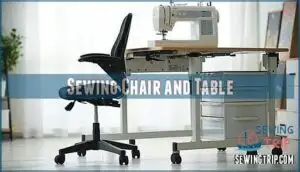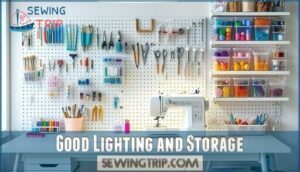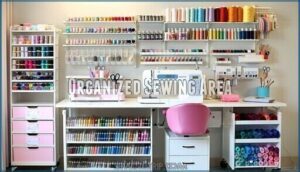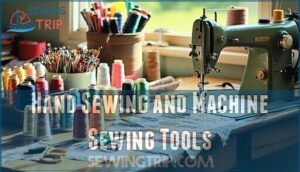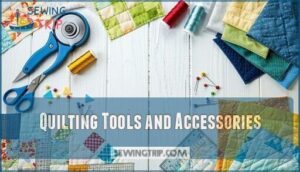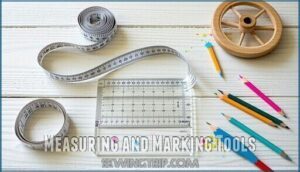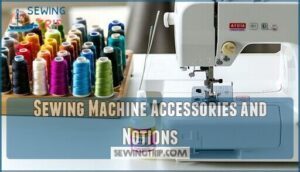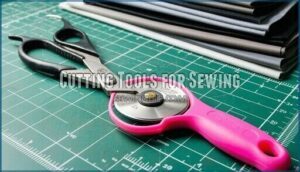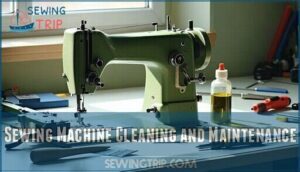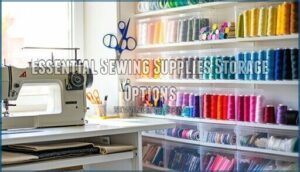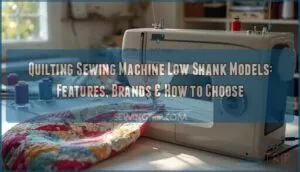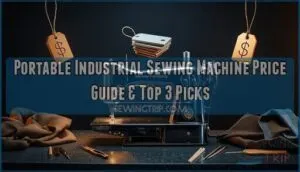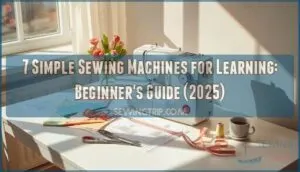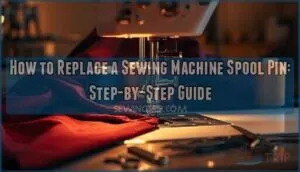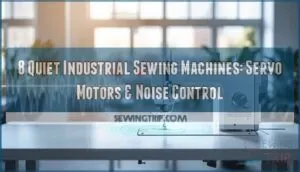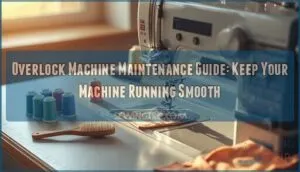This site is supported by our readers. We may earn a commission, at no cost to you, if you purchase through links.
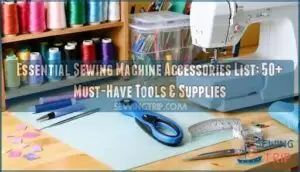 Your essential sewing machine accessories list should include presser feet for different techniques, sharp needles in various sizes, and quality thread that won’t break mid-project.
Your essential sewing machine accessories list should include presser feet for different techniques, sharp needles in various sizes, and quality thread that won’t break mid-project.
You’ll need extra bobbins, a reliable seam ripper for those "oops" moments, and fabric scissors that cut like butter.
Don’t overlook measuring tools like tape measures and rulers, plus marking tools such as fabric chalk or disappearing ink pens.
A cutting mat and rotary cutter make quick work of straight lines, while pins and clips hold everything in place.
Machine oil and cleaning brushes keep your equipment humming smoothly, and smart storage solutions can transform your sewing experience from frustrating to fantastic.
Table Of Contents
- Key Takeaways
- Essential Sewing Machine Accessories
- Essential Sewing Machine Accessories List
- Setting Up Your Sewing Space
- Hand Sewing and Machine Sewing Tools
- Quilting Tools and Accessories
- Measuring and Marking Tools
- Sewing Machine Accessories and Notions
- Cutting Tools for Sewing
- Sewing Machine Cleaning and Maintenance
- Essential Sewing Supplies Storage Options
- Frequently Asked Questions (FAQs)
- Conclusion
Key Takeaways
- You’ll need basic presser feet, sharp needles, and quality thread as your foundation, then add specialty feet like walking feet and buttonhole feet to expand your machine’s capabilities for different techniques and fabrics.
- Keep essential cutting tools like fabric scissors, rotary cutters, and self-healing cutting mats sharp and dedicated to fabric only—they’ll give you clean, professional edges that make your finished projects look store-bought.
- Invest in reliable measuring and marking tools including tape measures, rulers, and fabric marking pens that disappear, since accurate measurements and clear markings prevent costly mistakes and frustrating do-overs.
- Create an organized storage system with clear bins, rolling carts, and tool organizers to keep your accessories within arm’s reach—good organization transforms chaotic sewing sessions into smooth, enjoyable creative flow.
Essential Sewing Machine Accessories
Your sewing machine becomes much more powerful when you pair it with the right accessories, from specialty presser feet that create perfect buttonholes to bobbins that keep your thread flowing smoothly.
These essential tools, which include different needle types for various fabrics, measuring guides, and cleaning supplies, transform basic stitching into professional-quality projects that’ll make you wonder how you ever sewed without them, utilizing the full potential of your sewing machine with the right accessories.
Sewing Basics
Before diving into your first project, you’ll need to master sewing fundamentals.
Your sewing machine accessories work together like a well-oiled team—sewing machine needles pierce fabric cleanly, bobbins sewing machine hold bottom thread, and sewing machine feet guide your stitching.
Learn basic stitch types like straight and zigzag first. Smart fabric selection starts with cotton or linen for beginners.
Understanding seam finishes prevents fraying, while pattern reading skills reveal endless possibilities.
Don’t forget your trusty seam ripper tool—everyone makes mistakes! Master hand sewing basics too, as they complement machine work perfectly.
Beginner Sewing Projects
The magic happens when you tackle your first real project with the right sewing machine accessories and beginner sewing supplies.
Start with easy fabrics like cotton, which forgives mistakes and handles predictably.
Simple patterns build confidence while teaching essential techniques through small projects that won’t overwhelm you.
Your beginner sewing supplies list should include these essentials:
- Cotton fabric that’s forgiving and easy to work with
- Basic patterns like tote bags or simple pillowcases
- Sharp fabric scissors for clean, precise cuts
- Quality thread that matches your first garment perfectly
Quick stitches and patience transform beginners into confident sewers, and with the right beginner sewing supplies, you can achieve this transformation.
Must-Have Sewing Tools
Building your sewing arsenal starts with the right foundation pieces.
Sharp Fabric Scissors slice through material effortlessly, while quality sewing machine needles keep your stitches consistent.
Seam Rippers rescue you from threading disasters—trust me, you’ll need them more than you think.
Measuring Tools like tape measures guarantee accuracy, and pins lock fabric in place during cutting.
Don’t forget Cutting Mats to protect your surfaces and extend blade life.
Presser Feet transform your machine’s capabilities, making specialized tasks manageable.
These essential tools form your sewing foundation, turning challenging projects into manageable victories.
Essential Sewing Machine Accessories List
Your sewing machine accessories list determines whether projects sing or stumble.
Smart sewers know the right tools make all the difference.
Essential sewing machine accessories transform your creativity:
- Needle Types: Universal, ballpoint, denim, and embroidery needles handle different fabrics perfectly
- Presser Feet: Zipper, buttonhole, walking, and quilting feet expand your machine’s capabilities dramatically
- Bobbin Types: Stock plastic and metal bobbins, plus pre-wound options for convenience
- Thread Selection: Quality polyester, cotton, and specialty threads prevent frustrating breaks
Add maintenance tools, and you’ll keep everything running smoothly for years.
Setting Up Your Sewing Space
Your sewing space sets the foundation for every successful project, so you’ll want a comfortable chair, sturdy table, and bright lighting that won’t strain your eyes during those late-night stitching sessions.
Smart storage solutions and an organized layout keep your tools within reach, turning your creative corner into a productive haven where inspiration flows as smoothly as your thread.
Sewing Chair and Table
Your comfort makes or breaks those marathon sewing sessions.
Ergonomic seating with proper posture support prevents backaches, while adjustable table height keeps your machine at elbow level for workspace comfort.
Smart storage solutions keep essentials within arm’s reach, turning your area into an organized haven.
| Feature | Chair Requirements | Table Specifications |
|---|---|---|
| Height | Adjustable 16-21" | Matches elbow height |
| Support | Lumbar cushioning | Sturdy, vibration-free |
| Storage | Built-in compartments | Drawers for supplies |
| Mobility | Rolling casters | Fixed or adjustable legs |
Good Lighting and Storage
Creating your dream sewing sanctuary requires strategic task lighting and smart storage solutions that turn chaos into creative flow.
Proper ergonomics and space optimization boost your productivity while protecting your eyes and posture.
- Position adjustable LED lamps to eliminate shadows on your work surface
- Install wall-mounted pegboards for frequently used sewing tools
- Use clear, stackable containers for sewing supplies storage
- Maximize vertical space with floating shelves for sewing machine accessories
Organized Sewing Area
Maximizing your space optimization starts with smart tool placement strategies.
Position frequently used sewing machine accessories within arm’s reach of your machine.
Designate specific zones for fabric storage and pattern organization to streamline your workflow.
Your ergonomic setup should prioritize comfort and efficiency for extended sewing sessions, focusing on maximizing your space.
Hand Sewing and Machine Sewing Tools
You’ll need the right needles, thread, and cutting tools to tackle both hand sewing repairs and machine projects with confidence.
These essential tools form the backbone of your sewing kit, whether you’re hemming pants by hand or piecing together a quilt on your machine, which requires the right tools to work with confidence.
Needles and Thread
Your workspace is ready, now let’s talk about the dynamic duo that’ll make or break every stitch. Getting your needle types and thread weights matched properly transforms frustrating projects into smooth sailing adventures.
Here’s your needle-thread playbook:
- Universal sewing machine needles handle most cotton and polyester fabrics beautifully
- Ballpoint machine needles prevent snags when working with stretchy knits
- Thread tension affects stitch quality more than expensive thread types
- Hand sewing needles paired with a needle threader tool save time and sanity
Selecting the right needle is essential, so consider specialty needle options for different fabrics. Fabric compatibility starts with smart choices.
Fabric Scissors and Shears
Since you’ve mastered threading, it’s time to tackle precise cutting.
Quality fabric shears with ergonomic handles make all the difference—dedicate them solely to fabric, never paper.
Different blade types suit various fabric types, while left-handed shears guarantee comfort for southpaws.
Keep your fabric scissors sharp through proper sharpening techniques.
These essential cutting tools transform rough edges into professional results.
Rotary Cutters and Cutting Mats
Sharp fabric scissors get the job done, but rotary cutters take precision to the next level.
These rolling blades slice through multiple fabric layers effortlessly, making them perfect for quilting and straight cuts.
- Choose blade sizes – 28mm for curves, 45mm for general cutting, 60mm for thick fabrics
- Pick selfhealing cutting mats – they repair themselves and protect your blade
- Master safety features – always engage blade guards between cuts
Quilting Tools and Accessories
When you’re ready to tackle quilting projects, you’ll need specialized tools that make cutting, piecing, and finishing your quilts much easier and more accurate.
From rotary cutters that slice through multiple fabric layers to walking feet that keep your quilt sandwich moving smoothly, these quilting accessories transform your regular sewing machine into a quilting powerhouse.
Rotary Cutters and Quilting Rulers
Your rotary cutter fabric slices through multiple layers effortlessly when paired with a quilting ruler clear acrylic guide.
Choose blade types suited for your project—45mm for curves, 60mm for straight cuts.
Cutting techniques improve with practice on your cutting mat selfhealing surface.
Follow safety tips: always close the blade after use.
Check ruler markings for accuracy, and remember mat maintenance extends tool life substantially.
Quilting Pins and Sewing Machines
Once you’ve cut your fabric pieces, quilting pins become your best friend for keeping everything aligned perfectly.
Your sewing machine’s performance depends heavily on choosing the right pin types for each project.
Here’s what smart quilters know about pin selection:
- Glass-head pins won’t melt under your iron’s heat
- Ballpoint pins slide through knits without snagging delicate fibers
- Sharp quilter’s pins pierce multiple fabric layers cleanly
- Flower-head pins stay visible against busy fabric patterns
Machine quilting requires pins that won’t interfere with fabric feed or needle compatibility.
When your stitch regulation kicks in, you’ll want pins positioned away from seam lines.
The wrong pins can throw off your sewing machine’s timing, creating uneven stitches that’ll drive you crazy.
Store your pins in a magnetic dish – it’s a game-changer for keeping your workspace organized and your sewing machine accessories within easy reach.
Quilting Feet and Accessories
Specialized quilting feet turn your machine into a quilting powerhouse.
The walking foot feeds layers evenly, preventing bunching, while the darning foot enables free-motion quilting designs.
An open-toe foot gives clear visibility for precise stitching, and the quarter-inch foot creates perfect seam allowances.
These sewing machine accessories yield professional quilting results every time.
You can find various specialized quilting options online.
Measuring and Marking Tools
Accurate measurements and clear markings make the difference between a perfect fit and a sewing disaster, so you’ll want reliable tools like tape measures, rulers, and fabric markers in your arsenal.
These essential accessories help you measure twice, cut once, and mark precisely where every seam, dart, and hem should go, saving you from costly mistakes and frustrating do-overs, by allowing you to mark precisely and avoid errors, which is crucial for achieving a perfect fit.
Tape Measures and Seam Gauges
Beyond quilting precision, your measuring tape sewing adventures need rock-solid accuracy tools.
These flexible measuring tools become your sewing superpowers, delivering accurate measurement every single time.
Here’s your must-have lineup:
- Tape measure – flexible ruler for body measurements and fabric yardage
- Sewing gauge with sliding marker for consistent seam allowance spacing
- Seam creaser for sharp fold lines and hem accuracy
- Point turner for perfect corners and curved seams
- Gauge types including hem gauges for professional finishes
These measuring tools guarantee flawless results.
Rulers and Tailor’s Chalk
Rulers and tailor’s chalk create your measuring-and-marking dream team, transforming guesswork into precision. These fundamental measuring tools guarantee your projects look professionally finished every time.
Different Chalk Types work for various fabrics, while Ruler Materials like acrylic provide durability and clarity. Curve Rulers help navigate tricky armholes and necklines with ease.
- Clear acrylic rulers show fabric patterns underneath
- Traditional tailors chalk fabric marks wash out easily
- Accurate Marking prevents costly cutting mistakes
- Marking Removal keeps finished projects looking clean
Your fabric will thank you for the professional touch!
Fabric Marking Pens and Tracing Wheels
After mastering rulers and tailor’s chalk fabric basics, you’ll want marking pens and tracing wheels for detailed work.
These marking supplies offer precise pattern transfer with excellent color visibility and fabric compatibility.
Marking permanence varies by pen type—some feature marking pen disappearing ink, while others stay put.
Wheel types and pressure control let you customize marks perfectly.
| Tool Type | Best For | Special Feature |
|---|---|---|
| Water-soluble pens | Temporary marks | Disappears with water |
| Heat-erasable pens | Quilting projects | Vanishes with iron heat |
| Tracing wheel (smooth) | Delicate fabrics | Gentle pressure control |
| Tracing wheel (serrated) | Heavy materials | Deep, lasting impressions |
Sewing Machine Accessories and Notions
You’ll discover that specialty presser feet, liquid fray preventor, and elastic with insertion tools transform your basic sewing machine into a versatile powerhouse.
These accessories and notions bridge the gap between simple stitching and polished, store-bought results, making even tricky techniques feel manageable for sewers at any skill level, tackling everything from professional buttonholes to stretchy waistbands.
Specialty Presser Feet
Your sewing machine’s potential reveals with specialty presser feet—these game-changing sewing machine accessories transform ordinary projects into professional masterpieces.
Each foot tackles specific challenges, from tricky fabrics to complex techniques.
Essential sewing machine presser feet include:
- Blind hem foot – Creates invisible hems on curtains and garments
- Gathering foot – Automatically ruffles fabric while you sew
- Teflon foot – Glides smoothly over vinyl, leather, and sticky materials
Always check your sewing machine accessories guide for compatibility before purchasing these specialized tools.
You can find a variety of options online.
Liquid Fray Preventor and Adhesives
Every sewing enthusiast needs reliable fray preventor and adhesives in their toolkit.
These sewing essentials stop fabric edges from unraveling, especially on delicate materials like silk or stretchy knits.
Fabric glue types range from permanent vs. temporary options, giving you flexibility for different projects.
Apply liquid fray preventor to cut edges before they start fraying – it’s easier than fixing damage later.
These sewing notions also excel at repairing seam rips quickly.
Master adhesive application tips by testing on fabric scraps first, ensuring your fray prevention methods work perfectly every time.
Elastic and Bodkin or Safety Pins
Beyond preventing frayed edges, you’ll need elastic to add stretch and comfort to your garments.
Bodkin tools make threading elastic through casings effortless, while safety pins serve as reliable alternatives when you’re in a pinch.
Different elastic types and widths suit various garment applications, from waistbands to sleeves.
- Choose appropriate elastic width for your specific project needs
- Use bodkin alternatives like large safety pins for threading
- Keep safety pin uses versatile for temporary holds and threading
- Stock various elastic types in your sewing kit for different garment applications
Cutting Tools for Sewing
Sharp, quality cutting tools make the difference between frayed, uneven fabric edges and clean, professional-looking seams that’ll make you proud of your finished project.
Sharp tools are the difference between amateur mistakes and professional pride in every seam.
You’ll need reliable scissors, rotary cutters, and cutting mats to handle different fabrics and cutting tasks, from snipping threads to slicing through multiple layers of quilting cotton with precision.
Scissors and Rotary Cutters
Sharp tools transform your sewing from frustrating to fantastic. Quality fabric shears and a reliable rotary cutter are your cutting companions, each excelling in different scenarios.
Scissors types matter more than you think:
- Fabric shears: Perfect for curves, notches, and detailed work around patterns
- Ergonomic cutters: Slice through multiple layers with less hand strain
Blade sharpness directly impacts your results. Dull blades create ragged edges and frustrated sewers. Rotary maintenance keeps your cutter gliding smoothly, while sharp scissors make every snip clean and precise.
Cutting Mats and Safety Precautions
Quality cutting mats make rotary cutters shine like precision instruments.
Self-healing surfaces protect your workspace while extending blade sharpness—wood tables damage blades fast.
Mat material affects cutting techniques, so choose wisely for workspace safety and mat longevity.
Your cutting mat becomes your crafting companion, keeping fabric shears sharp and sewing machine accessories organized.
| Feature | Benefit |
|---|---|
| Self-healing surface | Extends blade life, smooth cuts |
| Grid measurements | Accurate fabric alignment |
| Non-slip backing | Prevents sliding during use |
| Rotary-safe material | Protects cutting mat from damage |
The right cutting mat can enhance your overall crafting experience by providing a smooth cuts experience.
Sewing Machine Cleaning and Maintenance
Your sewing machine works hard for you, so it deserves regular cleaning and maintenance to keep running smoothly for years to come.
With the right tools like cleaning brushes, oil, and compressed air, you’ll prevent costly repairs and guarantee your machine stitches perfectly every time.
Cleaning Tools and Supplies
Now that you’ve got your cutting game on point, let’s talk about keeping your sewing machine purring like a contented cat. Regular cleaning isn’t just busy work – it’s what separates the pros from the wannabes.
Your machine craves attention with the right cleaning arsenal:
- Lint brush sewing companions for whisking away fabric dust
- Sewing machine oil for smooth, quiet operation
- Compressed air cans for blasting stubborn debris
- Micro-fiber cloths for gentle surface polishing
Lint removal becomes second nature once you establish a routine. Dusting interior components prevents costly repairs, while bobbin cleaning guarantees consistent stitching. Don’t forget needle care – a clean needle means cleaner stitches.
Sewing machine cleaning tips from seasoned sewists: unplug first, work gently, and follow your manual’s guidance. Quality sewing machine cleaning tools and maintenance tools pay for themselves through extended machine life.
Regular Maintenance Tips
Now that you’ve got your cleaning supplies sorted, let’s talk about keeping your machine humming like a happy bee.
Oiling machine parts every 6 months prevents squeaky protests, while bobbin cleaning and needle replacement after each project keeps stitches smooth.
Don’t forget tension adjustment and feed dog care – your trusty companion deserves this TLC.
| Maintenance Task | Frequency |
|---|---|
| Sewing machine oil application | Every 6 months |
| Lint brush sewing cleanup | After each project |
| Needle replacement | Every 8 hours of use |
| Bobbin cleaning | Weekly with heavy use |
| Tension adjustment check | During annual servicing |
Essential Sewing Supplies Storage Options
You’ll find that organizing your sewing supplies with the right storage options transforms your creative workspace from chaotic mess to efficient haven, making every project flow smoother and faster.
Smart storage solutions like dedicated tool organizers, clear bins, and strategic shelving keep your threads, needles, scissors, and notions easily accessible while protecting your investment in quality tools, utilizing smart storage solutions and maintaining an efficient haven.
Sewing Tool Organizers
Once your machine runs smoothly, you’ll need smart sewing organization to keep tools accessible.
Sewing boxes with compartments prevent small notions from disappearing, while rolling carts bring supplies directly to your workspace. Wall organizers and pegboards maximize vertical space beautifully.
Transform your sewing room setup with these clever solutions:
- Storage bins with clear lids for quick identification
- Magnetic strips that hold scissors and rulers securely
- Drawer dividers for sewing machine accessories storage
Smart sewing supplies storage turns chaos into creative flow.
Storage Bins and Shelves
Organization becomes your best friend when tackling sewing space chaos.
Smart storage bins and shelves transform cramped areas into efficient workstations, maximizing every square inch available.
| Storage Type | Best For | Space Needed | Cost Range |
|---|---|---|---|
| Clear Bins | Small notions, threads | Minimal | $5-15 |
| Rolling Carts | Portable supplies | Medium | $30-80 |
| Wall Shelves | Heavy items, books | Vertical | $20-50 |
| Drawer Units | Flat patterns, tools | Floor space | $40-120 |
Label everything for quick access.
Mobile carts offer flexibility, while DIY solutions save money.
Your sewing room setup deserves thoughtful bin organization and strategic shelf placement for ideal space optimization and creative flow.
Frequently Asked Questions (FAQs)
What are must haves for sewing?
You’ll need fabric scissors, seam ripper, measuring tape, pins, needles, thread, and a good iron.
Don’t forget pattern paper, marking tools, and a basic sewing machine with essential presser feet for successful projects.
What is the most essential equipment in sewing?
Sure, you’ll definitely need seventeen different presser feet before you even think about thread!
But honestly, your sewing machine itself is the most essential equipment—it’s the heart that brings every project to life.
What should be in a basic sewing kit?
Your basic sewing kit should include fabric scissors, seam ripper, measuring tape, pins, hand-sewing needles, thread in basic colors, marking tools like chalk, and a small cutting mat for precision work.
What are the useful sewing tools?
Essential sewing tools include fabric scissors, measuring tape, seam ripper, pins, needles, thread, marking tools like chalk, rotary cutter, cutting mat, iron, and presser feet for your machine’s versatility.
What sewing machine accessories are necessary?
Like a toolkit fuels a craftsman, you’ll want presser feet for different tasks.
Quality needles matching your fabric, sturdy bobbins, versatile thread varieties, and maintenance tools to keep everything running smoothly for years.
What equipment do you need to learn to sew?
You’ll need fabric scissors, measuring tape, pins, seam ripper, and marking tools.
A basic sewing machine with universal needles, all-purpose thread, and simple presser feet gets you started making your first projects, using basic tools to create.
What supplies do you need to sew a sewing machine?
Thread, bobbins, and needles form your sewing machine’s foundation.
You’ll need presser feet for different techniques, scissors for cutting, pins for holding fabric, and basic maintenance tools to keep everything running smoothly, including the use of basic maintenance tools.
What sewing supplies should be kept in a sewing tool organizer?
You’ll want scissors, seam rippers, measuring tape, pins, needles, bobbins, thread spools, marking tools, buttonhole cutters, and rotary blades organized neatly.
Don’t forget small brushes for cleaning—they’re lifesavers when lint builds up!
Do you have a list of basic sewing tools for beginners?
You’ll definitely want fabric scissors, pins, measuring tape, seam ripper, and basic thread colors.
Add a rotary cutter, cutting mat, marking tools, and universal sewing machine needles to cover most beginner projects comfortably.
What tools should I Keep near my sewing machine?
Keep scissors, seam ripper, extra needles, bobbins, measuring tape, pins, and your favorite thread within arm’s reach.
You’ll also want good lighting, small scissors for trimming, and a pin cushion for quick access.
Conclusion
Building your essential sewing machine accessories list is like assembling a toolkit for creativity—each piece reveals new possibilities and smoother projects.
You’ve now got the roadmap to transform your sewing space from basic to brilliant.
Start with the must-haves like quality scissors, presser feet, and measuring tools, then gradually add specialized accessories as your skills grow.
Remember, investing in the right tools isn’t just about convenience—it’s about turning every sewing session into an enjoyable, successful experience with the right sewing space.

